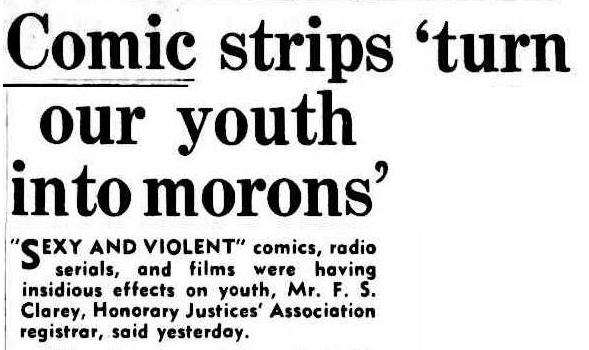
In the early hours of Monday the 26th of May 1952, a conspicuous-looking sedan is found patrolling Melbourne’s Bourke Street. To the front and rear of the car, two long aerials are poised ready to intercept any incoming police chatter. The radiator holds a makeshift flag bearer and a pennant displaying the names “Bat-Man and Robin”. Our caped avenger leans across the passenger seat and adjusts the portable radio to police radio control number, D24. Dressed in a black cloak and dark blue cowl, he looks in the rear-view mirror and smiles to himself. In the back seat of the sedan lies identification papers and sets of fingerprints for both Bat-Man and Robin. A single piece of paper instructs its reader that, “All communications for Bat-Man and Robin should be addressed to the Chief of Police Headquarters, Russell st., Melbourne”.
The masked (soon to be un-masked) boy, was intercepted by police officers shortly after 3.00 am. According to a report the 17-year-old had been frequently borrowing his stepfather’s car to make “secret night patrols as Bat-man for several weeks”. In his apprehension, Bat-Man implicated a 13-year-old boy who played the part of Batman’s sidekick, Robin.

One could be forgiven for dismissing this misdemeanour as an act of teenage rebellion. In 1952 however, their actions had inadvertently drawn the spotlight to a debate that had been bubbling away for some time; the Americanisation of a generation of Australian children and their subsequent moral corruption. The following day, a page five article in The Argus warned its readers that comic strips, “turn our youth into morons.” Questioned by journalists, Honorary Justices’ Association registrar, Mr F.S. Clarey called on the Government to, ‘ban all questionable entertainment for children and teenagers.’ Clarey used the weekend Bat-Man as an ‘instance of the effect of some comics on imaginative children’ and would use the example to advocate the Victorian State Government in the implementation of a censorship board to combat the ‘nation-wide craze for trash entertainment.’

Fears of the impact of comics, pulp, and horror stories were not confined to the vacuum of 1950s Australia. From 1952 to 1955, governments from the United Kingdom, United States, Canada, and New Zealand all sought to restrict the publication and distribution of this popular format. Citing fears of violence and delinquent behaviour, Australian state governments took a range of approaches to the issue. Queensland introduced the Objectionable Literature Bill in 1954 that culminated in the establishment of the Literature Board of Review. Victoria and New South Wales took a softer approach to the encroachment on publisher rights, implementing a registration system to improve the accountability of publishers. Sydney based publisher of comic books, pulp fiction, and popular fiction, Horwitz Publications, was one of the first publishing houses in the world to develop their own Code of Conduct. The Horwitz Publications stamp of approval adorned their front covers from 1954, advising children and parents alike that the work they were reading, ‘Conforms to the Horwitz Publications Juvenile Code of Approved Reading”.
The publication of Fredric Wertham’s Seduction of the Innocent in 1954 served to further fuel calls on the banning of obscene material. Wertham warned that the consumption of transgressive materials by young people, directly led to cases of delinquency, a warped sense of sex, violence, and morality. Australian politicians and other parties with vested interests often cited Wertham’s work to lobby for law reform and stricter censorship laws.
It is important to note that the flurry of outrage against comic books was not only in reaction to the perceived moral corruption of Australian youth but served as evidence of the increased Americanisation of children. The World War II era and the subsequent enforcement on trade embargoes of overseas print heralded what is now referred to as “The Golden Age” of Australian comics. Local artists and illustrators had free reign to create and publish relevant and antipodal content that not only reflected Australian culture but also produced more wholesome material. The cessation of trade embargoes at the end of the war opened the flood gates for American and British comics to dominate the market once again.

Often the whipping boy for political opportunism, the Australian comic book has a fascinating yet tumultuous history. Far from leading to the corruption of Australian youth, it inspired generations of disenfranchised and disaffected youth to whack on a pair of undies over tights and fight the good fight.
State Library Victoria collects all forms of popular culture, including publications such as comics, graphic novels and zines. Further information on our wonderful collection can be found here:
https://www.slv.vic.gov.au/search-discover/explore-collections-format/zines-comics-graphic-novels



Fabulous blog Daniel, love the story about bat boy and Robin prowling the Melbourne streets in 1952
Thanks Andrew! It would have been quite the sight.
A great blog, Daniel. Really interesting. I wonder what happened to those boys?
Thanks Alex. It would be great if we could find out.
This is terrific! Thank you so much for blogging about it. The 17 year old and his kid brother are definitely super heroes!
Thanks Jay! I completely agree.
I was growing up in the 1950s, and too young to be aware of the anti-comic furore. (However, having seen some of the comics-for-adults that were published in the 1950s and 1960s in the USA, full of violence, horror, and sex — hair-curling comics that were never available legally in Australia! — I understand what was REALLY being objected to.)
I especially liked Walt Disney comics (Donald Duck, Uncle Scrooge, Mickey Mouse, and film-based special-issue comics — the comic version of popular films like “Davy Crockett”).
I also like Phantom comics.
By 1960 I began reading “Classics Illustrated” comic book retellings of great literature, which, even today, I believe were and are educational and extremely valuable.
I knew, but was not as interested in, “Nancy and Sluggo”, “Dennis the Menace”, and “Archy and Veronica”.
And, of course, I knew and liked early “Superman” and “Batman”. (The modern versions leave me aghast. But I am now an old fuddy-duddy.)
Of course, there were the great newspaper comic strips both daily, and on Saturdays.
“Radish”, “Frisky the Rabbit”, “Mandrake the Magician”, and “Brick Bradford”.
I was aware, also, of some of the local comics, such as “Hop Harrigan”, and Australian outback equivalents to cowboys.
For me, the British comics were irrelevant(“Beano” and “Dandy”), except for Rupert Bear, and Dan Dare, and Toby Twirl.
ONCE I came across an AUSTRALIAN science fiction comic. This was, as I recall, sixty years later, set in a future version of Sydney, unbelievably modernised, encased in a vast transparent dome. The hero (and title of the comic, I believe) was “Captain Silver”, and he was a rocket ship pilot and a kind of space warrior.
No history of comic strips, and no internet search, has ever found this — so far.
I wonder if anyone knows this comic?
It was, I think, the FIRST issue or number of a projected series that may never have continued.
Thank you for your insights, John. You are correct that the “anti-comic furore” focused on the horror genre in particular, but it is no surprise that all facets of comic book production and consumption were thrown into the same pot.
The 1940s produced some iconic Australian comic book characters that I think contributed to the idea of the “larrikin”.
I don’t think I can help you with “Captain Silver”. There was a mid-50s comic called “Captain Silver Flash”, but that was a water-themed adventure comic. You could reach out to the Melbourne Science Fiction Club if you wanted to follow it up.
John, are you perhaps thinking of “Silver Starr”? I know sometimes my memories get shuffled around as time goes by, so I hope this is what you’re looking for! Some pictures below.
https://bit.ly/3933Cvh
https://bit.ly/3lpSJJu
What a great story Daniel – thankyou for telling it – and in the context of the times as well.
Thanks Jane!
One more query, please.
Among the “Donald Duck” comics I read (including the great “Uncle Scrooge” adventures, the best written by Carl Barks), one short story stuck in my memory, but I have never seen it since.
Donald and his three nephews discover a strange ostrich-like bird that lays large eggs and has a clucky call of “Money-cluck, money-cluck”.
The eggs hatch, revealing the contents to be MONEY — paper notes.
Suddenly the ducks are fabulously wealthy, or poised to be.
Just as suddenly, the newly hatched money turns to peanuts, raw peanuts in their shell.
The ducks resort to opening a roast peanut stall!
Can any “Donald Duck” enthusiasts let me know if this is by Carl Barks? And when it was published?
Internet searches have been unhelpful.
I luckily came across this great Blog.
As a Collector of, please do not give me too much Grief People – of Old/ Vintage Archie Comics (started in my Childhood during the Seventies), I do see the Value of Comics, but also have read many of the Pulp Comics, Books and Horror Comics of the 1950’s and can seen why there was alarms being set off, during those years. The problems with these sorts of things, they can become very much like a Witch Hunt, which I hate,but won’t go into that.
So I’ll stop jabbering on and say I really enjoyed reading this as being a Comic lover and lover of unusual stories of Melbourne (Australia) before it lost some of it’s Charm and some of it’s Larrikan ways. So A BIG thankyou for this and now to find out more about The 17yr old, Batman Boy of Melbourne.
Thanks Mimi. Really happy to hear your experiences as a collector.
Being of an age, my limited interest in comics was in the late 30s and early 40s. The one I
saw was ,i think, called “Chips”and I don’t think it influenced me in any way.
These days I see computer games as being the highly dangerous on our youth.
An excellent story that highlights the impact pop culture, American and otherwise, has had across generations and the knee-jerk reactions by those in authority that have been directed to society’s “youth” since Moses was a boy! Well done Mr Wee!
Thanks Brad!